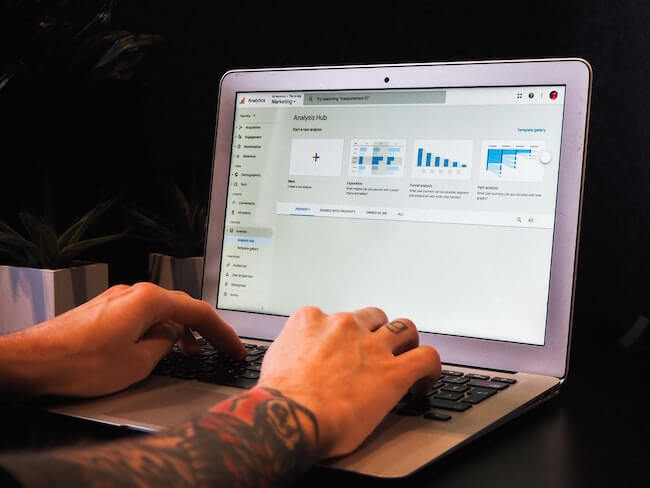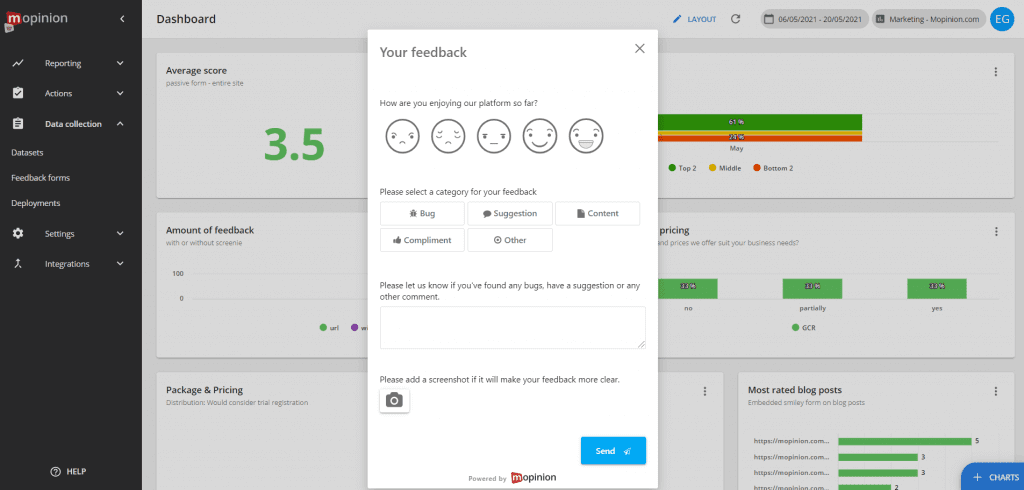When you think of conversion rate optimisation, you’ll probably think of A/B testing or experimentation immediately. Your goal is to increase conversions, so you know something needs to change, meaning you start looking for ways to improve. By performing A/B testing and experimentation, you can justify your hypotheses before making the appropriate changes to improve your website. But before you can come up with the correct hypotheses, you will first have to take a step back. Start off by doing some pretty extensive research as well as a conversion optimisation analysis.
As a digital marketer, you’ve probably heard of quantitative and qualitative analysis with the goal of optimising conversion. In this blog we explain what the difference between these terms is, how they complement each other and why this analysis phase is so important for increasing the number of conversions on your website or webshop. Let’s start with the quantitative analysis. Most companies use these methods to scrutinise their website. By performing quantitative analysis, you can peek into and discover what your visitors encounter.

The quantitative analysis
When you perform the quantitative analysis, there are several methods that help you with this, and these different methods also complement each other. With this method, you can easily spot the drop-off moments in the funnel, the pages where users leave your website and which landing pages provide the most visitors.
1. Web analytics
Nowadays, everyone works with tools such as Google Analytics, Adobe Analytics or Piwik. These tools are extremely handy when it comes to giving insight into the conversion funnel. When do most visitors drop out? Which landing page scores well? Through which channels do a visitor come to your website? What actions are performed on your website? Web analytics tools collect objective website statistics and measure the number of conversions.
2. Technical analysis
If a visitor does not convert, there could also be a technical issue, so keep a close eye on how your website or webshop functions. Is the loading time fast enough? Does everything work with the most common browser types? Is there a difference in the conversion per device? With Google Test My Site you can measure whether your mobile website is fast enough, or whether the images are good, etc. If you want to take a closer look at the desktop version of your website, you can use GT Metrix or Pingdom. Not only do these tools scan your website, they also provide useful tips and recommendations to improve your site.
3. Mouse Tracking
There are all kinds of useful tools if you want to analyse the mouse movements of your visitors. By checking the mouse movements, you gain insight into how someone navigates through your website and, for example, whether someone bumps into something and therefore leaves your website. If you use a heat mapping tool, you can see where clicks are or are not made. Crazy Egg wrote a blog about this. There are also tools such as Mouseflow to check how your visitors scroll and see the most important content. You can also choose to record a session, allowing you to see what the visitor is doing and where it’s potentially going wrong. The only thing missing here is that you don’t know why a visitor does what he does, and that, my friends, is what’s most important.
Discover the ‘why’ behind the ‘what’
However, in addition to these hard facts, you’ll want to know more details and background information. Quantitative data is usually obtained in large quantities, which means that you can most certainly gain insight into what is going well and what is not. But to really get to know your visitors, you want to know why certain choices are made and what drives someone to use your product. To gain insight into this, you need a qualitative analysis. The ‘why’ of this analysis complements the ‘what’ of the quantitative analysis.
It’s time to state the facts with the reasons behind customer behaviour.

Example of collecting qualitative feedback with Mopinion
Qualitative analysis:
1. Collect feedback. Look, now we’ve come to an interesting point, because coincidentally, we are experts in collecting, analysing and managing digital feedback. Whether you want to increase the number of conversions from your website, mobile app or email campaigns. By analysing the feedback, you really get to know customers or users. Read in this blog about which KPIs are important to achieve your goals and how to collect feedback via your website. You can collect feedback in a passive way (by means of feedback buttons) or actively (by means of triggers). By asking for feedback in strategic places, you gain insight into what your customers are encountering.
Examples of strategically asking for feedback on your website:
- Exit poll (when someone threatens to leave the page)
- Survey thank you page (did everything go well?)
- Survey page (on a specific page)
Not only where and when you ask for feedback is important. The way in which you analyse and manage the feedback received also plays a major role in the success of the qualitative analysis.
If you use software from Mopinion you can take advantage of very advanced features. You can view the results in dashboards that you can set up completely according to your own wishes, and with the handy ‘enhanced exports’ you can easily share the results with your colleagues and enrich them with other data that you collect with other tools. And with text analytics, you can discover the sentiment of the feedback. This gives you better insight into what your customers really think.
After all, it’s not just about which words are used, but also how the words are intended. There are many more valuable features that you should try out for yourself. You know which KPIs are important, how you want to collect and analyse feedback and how it is followed up.

2. In-depth interview with users. Schedule phone calls with your clients or invite a select group to your office. During these conversations you will learn a lot, you can easily ask questions or ask for clarification. You can also explain your side and ensure that you get even closer to your customers. You can use this sample template as a starting point. The downside of the interviews is that it is time-consuming and one’s personal experience may not necessarily be representative of other clients. Fortunately, there are also plenty of agencies that you can hire to conduct the interviews for you.
3. Usability testing. If you want to test the usability of your website or app, you want to know how user-friendly and accessible it is. Does everything work efficiently and without errors, and what is the user experience like? You can already do this during the design phase, in the beta phase, but also if your product has been running for a while. You can perform a usability test by, for example, selecting a group of users and having them perform a specific task or assignment. But also by supplementing A/B tests with customer feedback. This way you find out how your customer uses your product, whether something can be improved and what the user experience is like. If you want to know more about usability testing, this blog is recommended.
The best of both worlds
As you have read, both quantitative and qualitative analyses have their strengths. If you want to tackle conversion optimisation properly, you will have to perform both types of analysis. Only in this way can you gain insight into the pitfalls and obstacles of your customers, and you can ensure that you start working with the right hypotheses. By supplementing the hard facts of the quantitative analysis with the sentiment of the qualitative analysis, you know why someone does or does not perform a certain action. And if you know that, it is a lot easier for you to recognize and tackle areas for improvement. In short, the analysis is the first step towards conversion optimisation. Want to learn more about Mopinion’s all-in-1 user feedback platform? Don’t be shy and take our software for a spin! Do you prefer it a bit more personal? Just book a demo. One of our feedback pro’s will guide you through the software and answer any questions you may have.
Ready to see Mopinion in action?








